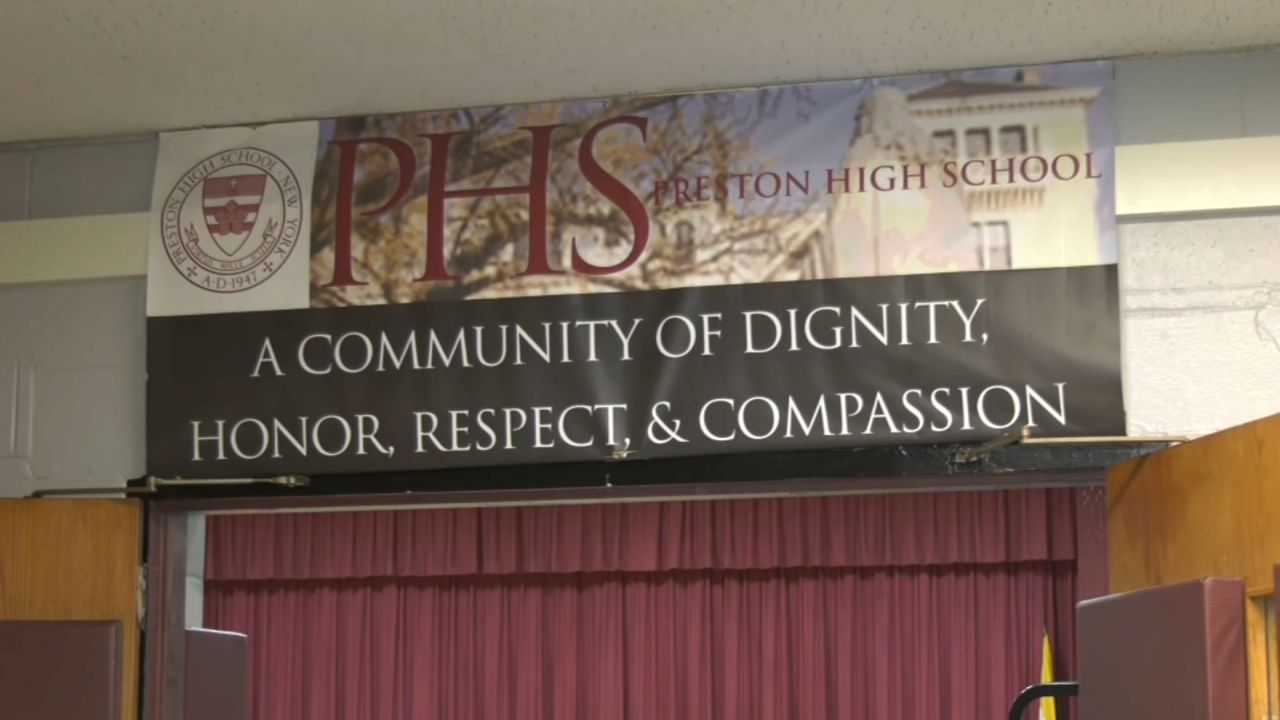Mia Simpson uses a wheelchair. She attended P.S. 138 in Harlem until the fourth grade, when she noticed all her friends were moving upstairs. She couldn’t, because the school had no elevator.
“A physical therapist thought maybe we can work out getting upstairs and downstairs as part of her sessions. But then the safety came in and you know that just wasn’t something that we can do,” her mom, Yuvania Espino, said.
Ultimately, her mom decided to change schools, and Mia now attends a private school at the city’s expense. She missed out on having a fifth-grade graduation with the children she’d known since kindergarten.
“It saddens me that a child has to be excluded from programs that they might enjoy, that they might like, just because of physical disability,” Espino said. “It makes me feel horrible for a parent who can’t really choose schools based on performance, based on what they have to offer. The last thing they should have to think about is, ‘will my kid be able to get in the building?’”
Mia isn’t alone. A new report from Advocates for Children found that two-thirds of the city’s public schools are not fully accessible to people with physical disabilities.
There are more than 1,400 school buildings in the city, some of them housing multiple schools.
This school year:
- Only 34% of those school buildings are fully accessible
- Nearly 20% are partially accessible
- Almost 5% are not fully accessible, but are in the pipeline for improvements
- And 41% of buildings are fully or functionally inaccessible.
AFC uses the term functionally inaccessible for buildings a wheelchair user may be able to enter, but which doesn’t offer any classrooms on the first floor, meaning they’re not an educational option for those students.
A partially accessible school has classrooms a child can access, but they may be cut off from huge parts of the building.
“You might be able to get in the door, but there might be whole areas of the building that are totally off limits. So you can’t get into the science lab. You can’t take that class or you can’t participate in certain clubs. You aren’t a full member of the school community,” Part said.
While the numbers are stark, they represent an improvement from 2018 — when AFC found just 19.5% of schools fully accessible. That, along with a 2015 investigation from then-U.S. Attorney Preet Bharara, spurred the city to invest $750 million in its capital plan to make improvements.
“The investment that was made five years ago has had a huge impact,” Sarah Part, senior policy analyst at Advocates for Children, said. “But because of where we started from five years ago, because of just the abysmal state of accessibility going into the last capital plan, there’s still so, so much more work to do.”
Advocates for Children is asking the city to keep investing by spending $1.25 billion in the next five-year capital plan. That would account for about 5-6% of the capital plan, which funds major construction project across the city over a five-year span.
“Given to how far we still have to go, it’s really just a drop in the bucket. We’re not going to get anywhere close to 100% full accessibility over the next five years,” Part said.
She says the $1.25 billion request is realistic: “It’s very achievable and it should be able to get us to about 50% full accessibility as far as primary locations for schools.”
A spokesman for the School Construction Authority pointed to the progress and $750 million plan acknowledged in the report.
“Working together, NYC Public Schools and the SCA have identified 65 accessibility projects and we are on track to make a third of the buildings throughout the city fully accessible and at least half of elementary school buildings fully or partially accessible,” spokesman Kevin Ortiz said. “We look forward to working with advocates, parents, and stakeholders on our next 2025-2029 capital plan to further advance this initiative to make more schools accessible.”
Inaccessibility doesn’t just affect students in a particular building, it can mean teachers, parents and siblings also can’t access certain schools.
Even now, after moving to an accessible school, Mia still finds herself shut out of events at her little sister Kira’s school like a recent performance held in a second-floor auditorium.
“I feel like it’s really unfair because sometimes I know that she could really enjoy it, and sometimes it would probably make her sad if she couldn’t come,” Kira said.
It’s an issue families face all the time when a loved one is in a wheelchair.
“I want people to understand how it makes families feel, to have to make those decisions of excluding a family member because of inaccessibility,” Espino said, noting Kira is just eight-years-old but already aware of making sure her sister can be included at places she visits.
“She wants her sister to be part of everything in her life. And the fact that a ramp or an elevator some mechanics deprive us from that is just something I wish people would keep in mind,” Espino added.




%20PKG%20CC%20Schools%20Accessibility_127232118_1688?wid=320&hei=180&$wide-bg$)

_CGPK_CUNY_Student_Protest_Encampents_2025_CG_134055132_345)


_DNT_Columbia_Protest_CLEAN_FOR_APPROVAL)